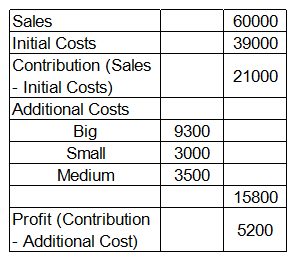1. A firm is thinking of buying a printer for its office use for the next one year. The criterion for choosing is based on the least per-page printing cost. It can choose between an inkjet printer which costs Rs. 5000 and a laser printer which costs Rs. 8000. The per-page printing cost for an inkjet is Rs. 1.80 and that for a laser printer is Rs. 1.50. The firm should purchase the laser printer, if the minimum number of a pages to be printed in the year exceeds
Show Similar Question And Answers
 Each of the Big, Small and Medium cost is categorized by the manager into Red, Yellow, Green and Violet costs. Breakdown of the additional costs under these headings is shown in the table below:
Each of the Big, Small and Medium cost is categorized by the manager into Red, Yellow, Green and Violet costs. Breakdown of the additional costs under these headings is shown in the table below: Red, Yellow, Green and Violet costs are allocated to different retail formats. These costs are apportioned in the ratio of number of units consumed by each retail format. The number of units consumed by each retail format is given in the table below:
Red, Yellow, Green and Violet costs are allocated to different retail formats. These costs are apportioned in the ratio of number of units consumed by each retail format. The number of units consumed by each retail format is given in the table below: Read the following statements:
Statement I. Online store accounted for 50% of the sales at BnC and the ratio of supermarket sales and book store sales is 1:2.
Statement II. Initial Cost is allocated in the ratio of sales. If you want to calculate the profit/loss from the different retail formats, then....
Read the following statements:
Statement I. Online store accounted for 50% of the sales at BnC and the ratio of supermarket sales and book store sales is 1:2.
Statement II. Initial Cost is allocated in the ratio of sales. If you want to calculate the profit/loss from the different retail formats, then.... Powered By:Omega Web Solutions
Powered By:Omega Web Solutions